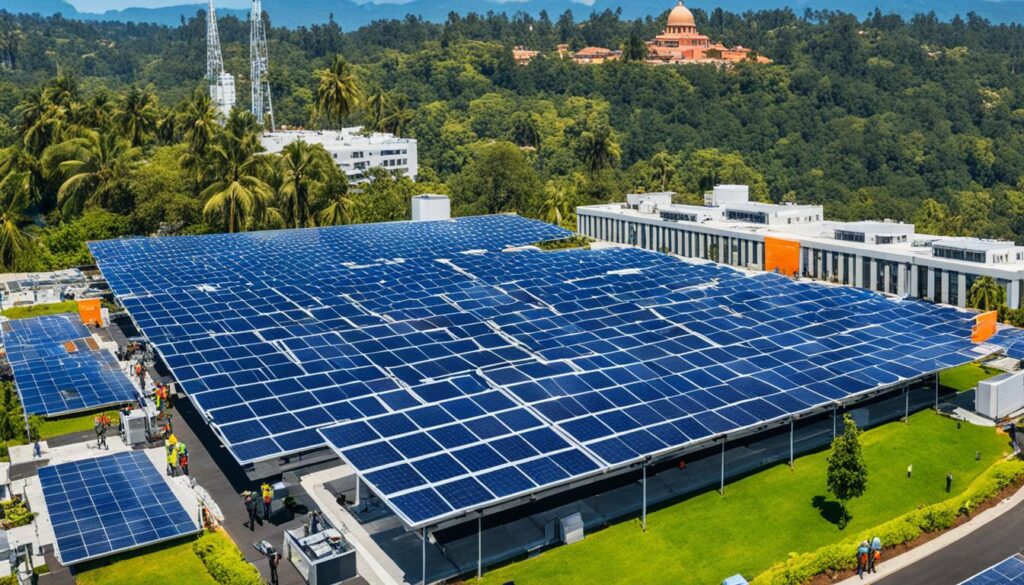
India, the world’s second-most populous country, is experiencing an extraordinary surge in the use of solar energy, ushering in a transformative era for the nation’s energy landscape. With a concerted focus on sustainable development and clean energy solutions, India has emerged as a global leader in harnessing the power of the sun.
The adoption of solar energy in India has been facilitated by a combination of factors, including increasing investments, favorable government policies, and a growing public awareness of the need for renewable energy sources. As a result, solar power has become a cornerstone of India’s long-term vision for a greener, more sustainable future.
The use of solar energy in India extends across various sectors, including residential, commercial, and industrial applications. From solar-powered homes and businesses to large-scale solar parks and installations, the potential for solar energy transformation in India is immense.
The widespread adoption of solar power in India has significant implications on both a national and global scale. Not only does it drive economic growth and job creation, but it also contributes to a reduction in greenhouse gas emissions and a more sustainable future for generations to come.
Key Takeaways:
- India is experiencing a remarkable surge in the use of solar energy, transforming the nation’s energy landscape.
- Government initiatives and policies play a crucial role in driving solar energy adoption in India.
- The country has witnessed impressive growth in solar capacity and installations, making it one of the largest solar power markets globally.
- Solar energy adoption in India offers economic benefits, job creation, and a reduction in greenhouse gas emissions.
- The use of solar energy in India is vital for achieving a sustainable and clean energy future.
Government Initiatives and Policies Driving Solar Energy Adoption
The Indian government has taken proactive measures to accelerate the adoption of solar energy and promote sustainability in the country. These initiatives and policies have played a crucial role in driving the growth of solar power capacity and installations across India, making it a prominent player in the global solar energy market.
Jawaharlal Nehru National Solar Mission (JNNSM)
One significant government initiative is the Jawaharlal Nehru National Solar Mission (JNNSM), launched in 2010. Its primary objective is to achieve a solar power capacity of 100 GW by 2022. Under this mission, various schemes have been implemented to encourage the widespread use of solar energy. These include:
- Rooftop Solar Installations: Encouraging households, commercial buildings, and industries to adopt solar panels and generate their own electricity.
- Solar Parks: Establishing dedicated areas for large-scale solar projects to maximize solar power generation.
- Solar Water Pumps: Promoting the use of solar-powered pumps for irrigation in agricultural areas, reducing reliance on traditional energy sources.
Through these schemes, the government aims to create a favorable environment for the development of solar energy projects in India.
Solar Energy Subsidies and Incentives
The government also provides subsidies, tax benefits, and other incentives to encourage individuals, businesses, and institutions to adopt solar energy solutions. These measures aim to offset the initial installation costs and make solar power more economically viable. Some key incentives include:
- Generation-Based Incentives (GBI): Offering financial incentives based on the amount of solar energy generated by an installation.
- Accelerated Depreciation: Allowing businesses to claim higher depreciation rates on solar equipment, reducing their tax liabilities.
- Net Metering: Allowing solar power system owners to sell excess electricity generated back to the grid, reducing their energy bills.
These subsidies and incentives have contributed to the affordability and attractiveness of solar energy solutions, driving increased adoption throughout the country.
“Government initiatives and policies have been instrumental in promoting the widespread use of solar energy in India. These measures not only contribute to the country’s renewable energy goals but also provide economic and environmental benefits.”

The table below provides a summary of the key government initiatives and policies driving solar energy adoption in India:
| Initiatives | Description |
|---|---|
| Jawaharlal Nehru National Solar Mission (JNNSM) | Launched in 2010, aims to achieve a solar power capacity of 100 GW by 2022. Includes schemes such as rooftop solar installations, solar parks, and solar water pumps. |
| Solar Energy Subsidies | Provides financial subsidies to offset installation costs and make solar power more affordable. Includes generation-based incentives, accelerated depreciation, and net metering. |
| Tax Benefits | Offers tax benefits to businesses investing in solar energy equipment, such as accelerated depreciation rates. |
| Renewable Purchase Obligation (RPO) | Requires power distribution companies to source a certain percentage of their energy from renewable sources, including solar power. |
| Off-Grid Solar Solutions | Promotes the use of off-grid solar solutions in remote areas without access to reliable electricity. |
Impressive Growth in Solar Capacity and Installations
India has experienced remarkable growth in its solar power capacity and installations, solidifying its position as one of the largest solar power markets globally. As of the latest available data, the country’s cumulative solar capacity has exceeded [Cumulative Solar Capacity] GW, reflecting the significant progress made in the adoption of solar energy.
This growth can be attributed to several factors. Firstly, the declining costs of solar panels have made it more accessible for both individuals and businesses to invest in solar installations. Additionally, advancements in solar technology have increased the efficiency and effectiveness of solar power systems, making them a more viable and lucrative option for energy generation.
Furthermore, the Indian government’s favorable policies and initiatives have played a crucial role in driving the growth of solar installations. The Jawaharlal Nehru National Solar Mission (JNNSM), launched in 2010, aims to achieve 100 GW of solar power capacity by 2022. Under this mission, various schemes such as rooftop solar installations, solar parks, and solar water pumps have been implemented to encourage widespread adoption of solar energy.
The states of Rajasthan, Gujarat, and Karnataka have emerged as leaders in solar installations, boasting several large-scale solar parks and projects. These states have harnessed their abundant solar resources and favorable geographical conditions to attract significant investments in the solar energy sector.
The continuous growth in solar power capacity and installations in India is a testament to the country’s commitment to sustainable and clean energy solutions. With decreasing costs, technological advancements, and supportive government policies, India’s solar sector is well-positioned for further expansion and is expected to continue thriving in the coming years.
| Year | Solar Power Capacity (GW) | Solar Installations (GW) |
|---|---|---|
| 2015 | 20 | 4 |
| 2016 | 25 | 5 |
| 2017 | 32 | 7 |
| 2018 | 42 | 10 |
| 2019 | 60 | 15 |

Solar Power Capacity and Installations Growth in India
“India’s impressive growth in solar power capacity and installations reflects the nation’s commitment to transitioning towards cleaner and more sustainable energy sources. This progress not only contributes to reducing carbon emissions but also enhances energy security and creates job opportunities.”
Economic and Environmental Benefits of Solar Energy Adoption
The adoption of solar energy in India offers numerous economic and environmental benefits. Solar power has the potential to reduce the country’s dependence on fossil fuels, leading to a decrease in greenhouse gas emissions and air pollution. By harnessing the power of the sun, India can mitigate the adverse environmental impacts associated with traditional energy sources.
Moreover, the widespread adoption of solar energy creates job opportunities across the solar value chain, contributing to economic growth and employment generation. From manufacturing solar panels to installation and maintenance, the solar sector drives job creation and skills development. This not only boosts the Indian economy but also promotes a more sustainable and inclusive workforce.
Renewable energy, specifically solar power, has attracted substantial investment, both domestic and foreign. The support from investors has propelled the growth of the solar sector, fostering innovation and technological advancements. With increased funding, research, and development, new technologies and efficient systems are being developed to harness and store solar energy more effectively.
Furthermore, the increased solar energy production has helped India meet the growing energy demands of its population while ensuring sustainability and energy security. As a clean and abundant source of power, solar energy can be harnessed in both rural and urban areas, reducing the reliance on costly and polluting fossil fuel-based electricity. This not only improves access to electricity but also enhances the resilience of India’s energy infrastructure.
FAQ
What is the current status of solar energy adoption in India?
India has witnessed a remarkable surge in the use of solar energy, leading to a transformative impact on the nation’s energy landscape. With increasing investments and government initiatives, solar power has become a key player in India’s quest for sustainable and clean energy solutions.
What are the government initiatives and policies driving solar energy adoption in India?
The Indian government has implemented several initiatives and policies to promote the adoption of solar energy. The Jawaharlal Nehru National Solar Mission (JNNSM) launched in 2010 aims to achieve 100 GW of solar power capacity by 2022. Under this mission, various schemes such as rooftop solar installations, solar parks, and solar water pumps have been implemented. Additionally, the government provides subsidies, tax benefits, and incentives to encourage solar energy adoption.
How much solar power capacity does India currently have?
As of [Latest Year], India’s cumulative solar capacity has surpassed [Cumulative Solar Capacity] GW, making it one of the largest solar power markets globally. The growth in solar installations can be attributed to the declining costs of solar panels, improved technology, and favorable government policies.
Which states in India lead in terms of solar installations?
The states of Rajasthan, Gujarat, and Karnataka lead in terms of solar installations, with several large-scale solar parks and projects.
What are the economic and environmental benefits of solar energy adoption in India?
The adoption of solar energy in India offers numerous economic and environmental benefits. Solar power has the potential to reduce the country’s dependence on fossil fuels, leading to a decrease in greenhouse gas emissions and air pollution. It also creates job opportunities across the solar value chain, contributing to economic growth and employment generation. Furthermore, increased solar energy production has helped in meeting the growing energy demands of India’s population while ensuring sustainability and energy security.








